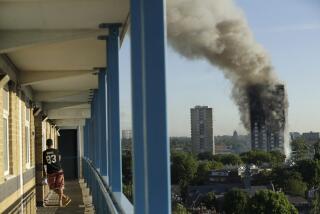Deconstructing a Tragedy
- Share via
There’s something morbidly fascinating about tonight’s episode of “Nova,” called “Why the Towers Fell.”
By now, the images of the two Boeing 767s gliding silently into the sides of the World Trade Center’s twin towers, and the subsequent explosions of fire, have left most of us numb. In the “Nova” documentary, the Sept. 11 images are repeated over and over again, from a variety of angles, and one’s first impulse is to turn away.
But the images are not gratuitous. They become important evidence in answering the PBS show’s central question: Could changes in the towers’ design have prevented their collapse? And the conclusions are unsettling. Although the twin towers were basically structurally sound, certain refinements in the design probably would have saved more lives.
The show is based on an investigation by a team from the American Society of Civil Engineers for the Federal Emergency Management Agency. (The last eight minutes of the show, focusing on the team’s final conclusions and its recommendations for future building safety, were not available for review. The study will be released in full on Wednesday.)
The investigation begins with an analysis of the twin towers’ structure, which was considered innovative for its time.
Unlike older skyscrapers, which are often supported on a dense grid of steel columns and beams, the trade center towers were mainly supported by a dense latticework of steel columns set along the buildings’ outer walls. A second system of columns was clustered at each building’s core, which housed the elevators and staircases. The idea was to create a completely open floor plan, unobstructed by the usual network of interior columns.
That meant that if either system failed, the tower would fall. And the show makes the case that the two towers failed for very different reasons.
Most of us know, for example, that when the first plane smashed into the north tower’s north facade, it left a gaping hole in the building’s exterior. But according to investigators, the more critical damage occurred inside, where the impact destroyed many of the core’s supporting columns. It also did severe damage to the drywall that was meant to protect the columns from fire. The subsequent blaze softened the remaining steel, and eventually the core began to collapse, bringing the rest of the building down with it.
In the case of the south tower, the core survived largely intact. But the extreme force of the impact shook loose the sprayed-on fireproofing that was intended to protect the steel floor trusses that held the exterior columns in place. Once the fire weakened the trusses, the exterior columns began to buckle outward, causing the tower to fall.
The show uses a range of video footage to hammer home this point. A slow-motion image of the north tower’s collapse shows the central antenna beginning to fall just before the building’s exterior envelope, confirming that the core gave way first. The south tower, by comparison, tilts slightly before crumbling to the ground, as if the reverse had happened.
The implication is clear: If the steel fireproofing had been more adequate, one, if not both, of the towers might have survived, at least for a little bit longer.
The show makes other, more subtle points that are equally unsettling. In each tower, all of the staircases were contained in the center. When the first plane destroyed the north tower’s core, it cut off the main escape route for those on the floors above. Had the core been constructed of concrete and steel instead of steel and drywall, one or more of the staircases might have survived, meaning that more people could have escaped.
But what finally makes the documentary so disturbing is its unspoken subtext. Terrorism is now a fact of life in America. Engineers, like the rest of us, will have to take into account a potential level of violence that, not so long ago, seemed totally unimaginable. And that, ultimately, is the show’s most painful message of all.
*
“Why the Towers Fell” can be seen on “Nova” at 8 tonight on KCET and KVCR.
More to Read
Sign up for Essential California
The most important California stories and recommendations in your inbox every morning.
You may occasionally receive promotional content from the Los Angeles Times.













